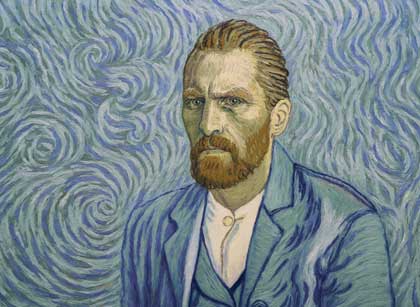Film (2016)
Directed by Dorota Kobiela and Hugh Welchman
Screenplay by Dorota Kobiela, Hugh Welchman, Jacek Dehnel
Head of Painting Piotr Dominiak; VFX Supervisor Lukasz Mackiewicz; Head of Production Tomek Wochniak; Music by Clint Mansell; Cinematography by Tristan Oliver, Lukasz Zal; Film Editing by Dorota Kobiela, Justyna Wierszynska; Production Design by Matthew Button, Maria Duffek,Andrzej Rafal Waltenberger; Art Direction by Daniela Faggio
Capitol Theater, Arlington, MA
Kendall Square Cinema, Cambridge, MA
With Robert Gulaczyk (Vincent van Gogh), Piotr Pamula (Paul Gaugin), Cezary Lukaszewicz (Theo van Gogh), Douglas Booth (Armand Roulin), Chris O’Dowd (Postman Joseph Roulin), John Sessions (Pere Tanguy), Helen McCrory (Louise Chevalier), Eleanor Tomlinson (Adeline Ravoux), Saoirse Ronan (Marguerite Gachet), Jerome Flynn (Doctor Gachet)

from “Loving Vincent”
Image: Courtesy of Breakthru Productions, Trademark Films
This film is entirely painted! Every last frame and sequence is produced by a team of 100 painters and the result is visually striking. Each scene is based on a van Gogh masterpiece, and, if one knows them, following them in each sequence is a huge barrel of laughs.
It is also brilliantly written. Conceived as a mystery story, with the son of Postmaster Roulin, one of van Gogh’s historic friends from Arles, as the emissary to Auvers-sur-Oise to figure out how van Gogh actually died, it traces the latest evidence and associated theories about his demise. The result is a completely satisfying and nuanced drama, artfully written, conceived and executed.
The mystery part involves the young Roulin pursuing what seems like a sketchy account about Vincent’s presumed suicide. By talking with a bunch of townspeople in Auvers-sur-Oise he uncovers what seem like the plausible components of an alternative explanation. But the culmination is even more nuanced than the quite nuanced alternative explanation and the way the screenplay interleaves the traditional and the more recent explanations is thoughtful and subtly delineated. It’s a lovely piece of writing.
The series of scenes that comprise the film are so wonderfully rendered that it is a constant entertainment for the eyes. The technique of having a kind of action painting form the animation of each scene is a brilliant one and it keeps things moving and totally fresh.
In an hour and a half one can, by virtue of tuning in, get the latest and greatest theory of van Gogh’s tragic death and, as well, drink in all the visual data that make his work so extraordinary.
It is truly shocking to think that van Gogh only painted for eight or so years before he died. By virtue of its visual improvisation on the originals, the film gives a very good sense of that amazing and varied output.
As well, the film conveys van Gogh’s fragile psychology and renders the sense of insecurity and loneliness that beset him. Always unsure of himself and continually feeling he was a failure, van Gogh persisted in painting with the verve, regularity and determination of a true artistic ascetic; the film’s unique style reveals that vulnerable genius that we have come to associate so vividly with his work.
A wonderful cast fills out the animations, including well-known actors Chris O’Dowd who plays Postmaster Roulin and Saorise Ronan who plays Marguerite Gachet, the famed Doctor Gachet’s daughter with whom van Gogh might have been in love.
This amazing Polish and British coproduction casts itself as the first entirely painted film. I certainly can’t think of another.
This is a heartbreaking and heartbreakingly good film. If you love van Gogh make sure you see it.
– BADMan
Leave a Reply